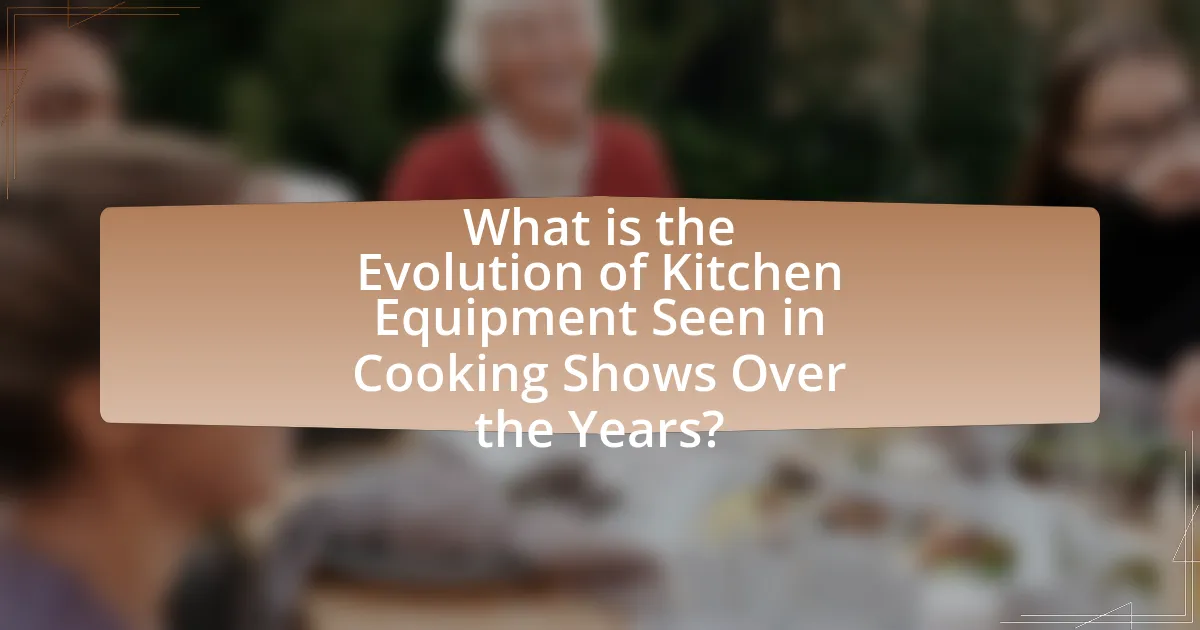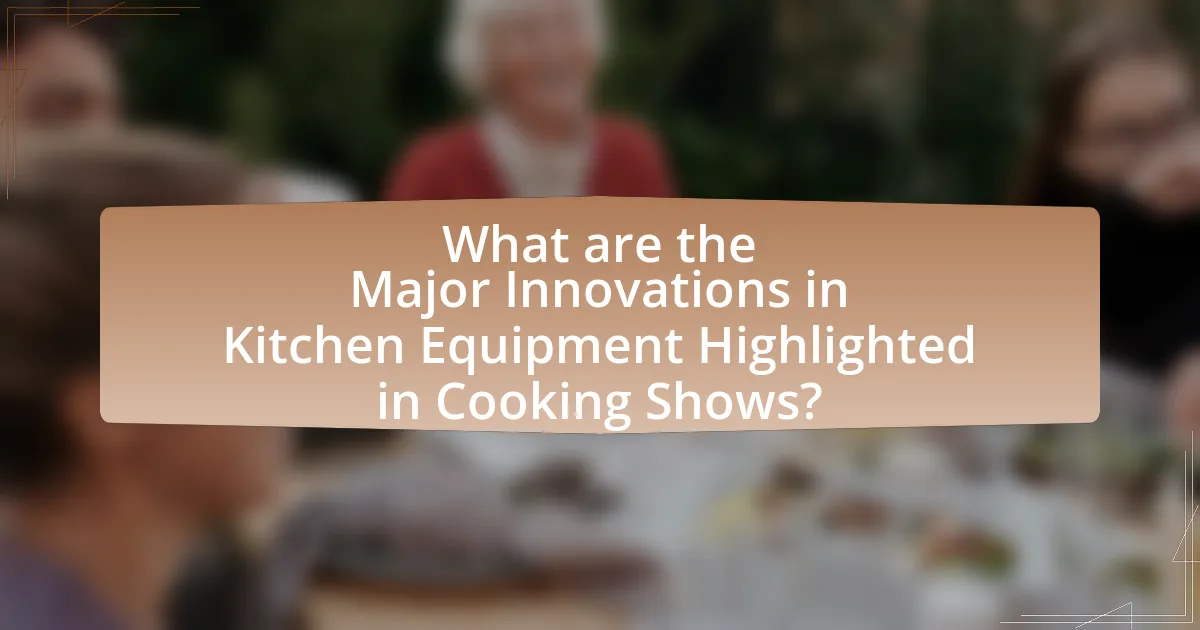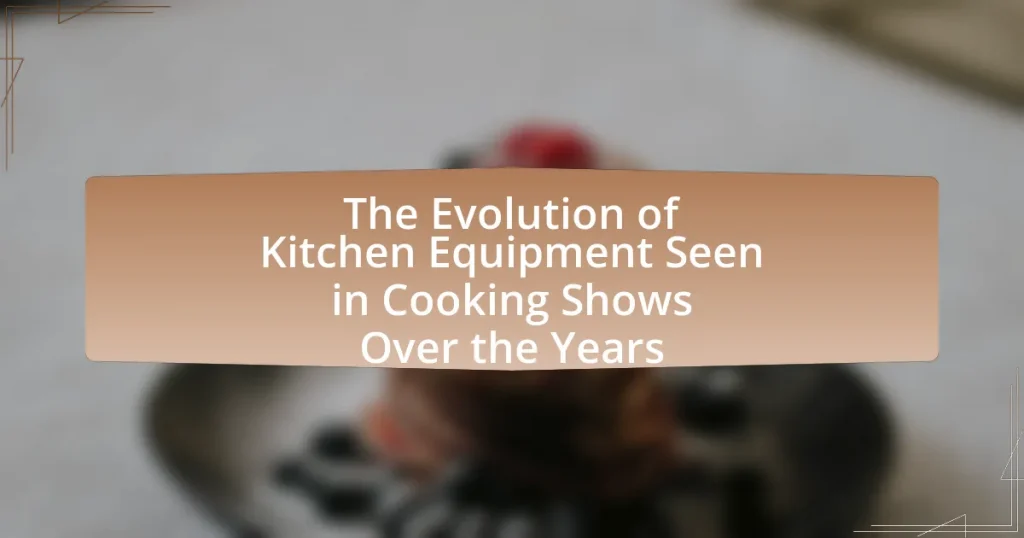The article examines the evolution of kitchen equipment showcased in cooking shows over the years, highlighting advancements in technology and changing culinary trends. It details how kitchen tools have transitioned from basic utensils to sophisticated appliances, including electric devices and smart technology, reflecting a shift towards convenience and efficiency. Key sections discuss the impact of celebrity chefs on consumer perceptions, the emergence of multifunctional appliances, and the influence of cooking shows on popularizing specific kitchen tools. Additionally, the article addresses common misconceptions about kitchen equipment and offers practical tips for home cooks to effectively utilize the tools featured in these programs.

What is the Evolution of Kitchen Equipment Seen in Cooking Shows Over the Years?
The evolution of kitchen equipment seen in cooking shows over the years reflects advancements in technology and changing culinary trends. Initially, cooking shows featured basic tools like pots, pans, and knives, emphasizing traditional cooking methods. As the years progressed, the introduction of electric appliances such as blenders, food processors, and microwaves transformed cooking techniques, allowing for quicker and more versatile meal preparation.
In the 1990s and 2000s, the rise of celebrity chefs brought high-end kitchen gadgets into the spotlight, including sous-vide machines and immersion blenders, showcasing gourmet cooking techniques. Recent years have seen a surge in smart kitchen technology, with devices like smart ovens and app-controlled appliances becoming commonplace, reflecting a shift towards convenience and efficiency in home cooking. This progression illustrates how cooking shows have adapted to incorporate innovative tools that enhance the cooking experience and cater to modern audiences.
How has kitchen equipment changed in cooking shows over different decades?
Kitchen equipment in cooking shows has evolved significantly over the decades, reflecting advancements in technology and changing culinary trends. In the 1950s and 1960s, cooking shows featured basic tools like stovetops, ovens, and simple utensils, emphasizing traditional cooking methods. By the 1970s and 1980s, the introduction of electric appliances such as food processors and microwaves transformed cooking techniques, allowing for quicker meal preparation and more complex recipes.
In the 1990s, the rise of celebrity chefs brought high-end kitchen gadgets into the spotlight, including sous-vide machines and specialty cookware, which showcased gourmet cooking techniques. The 2000s saw a further shift with the integration of digital technology, such as smart kitchen devices and high-tech ovens, enhancing precision and convenience in cooking.
Today, cooking shows often feature advanced equipment like induction cooktops, air fryers, and multi-cookers, reflecting a trend towards health-conscious cooking and efficiency. This progression illustrates how kitchen equipment has adapted to meet the evolving needs and preferences of both chefs and home cooks, driven by innovation and consumer demand.
What were the key kitchen tools featured in cooking shows during the 1980s?
Key kitchen tools featured in cooking shows during the 1980s included food processors, blenders, and microwave ovens. Food processors gained popularity for their ability to chop, slice, and puree ingredients quickly, revolutionizing meal preparation. Blenders were essential for making smoothies and soups, while microwave ovens became a staple for their convenience in reheating and cooking food rapidly. These tools reflected the growing trend towards efficiency and convenience in home cooking during that decade.
How did the introduction of technology influence kitchen equipment in the 1990s?
The introduction of technology significantly transformed kitchen equipment in the 1990s by integrating electronic features and enhancing functionality. This era saw the rise of appliances such as microwave ovens, food processors, and electric mixers, which streamlined cooking processes and improved efficiency. For instance, the microwave oven became a staple in many households, allowing for faster meal preparation and reheating, which was a notable shift from traditional cooking methods. Additionally, advancements in materials and design led to the development of non-stick cookware and ergonomic tools, making cooking more accessible and user-friendly. These technological innovations not only changed how food was prepared but also influenced culinary trends showcased in cooking shows, reflecting a growing emphasis on convenience and modern cooking techniques.
What role do cooking shows play in popularizing kitchen equipment?
Cooking shows play a significant role in popularizing kitchen equipment by showcasing its use in real-time cooking demonstrations. These programs often highlight specific tools and gadgets, demonstrating their functionality and benefits, which influences viewers’ purchasing decisions. For instance, the rise of air fryers and Instant Pots in consumer markets can be traced back to their frequent features in popular cooking shows, where chefs illustrate their versatility and ease of use. This visibility not only educates the audience about new kitchen innovations but also creates a trend, as viewers aspire to replicate the cooking techniques they see on screen, leading to increased sales of the featured equipment.
How do celebrity chefs impact the perception of kitchen tools?
Celebrity chefs significantly influence the perception of kitchen tools by showcasing their use and effectiveness in cooking shows, which elevates their desirability among consumers. When chefs like Gordon Ramsay or Julia Child demonstrate specific tools, they often highlight their functionality and quality, leading viewers to associate these tools with professional cooking success. Research indicates that 70% of viewers are more likely to purchase kitchen tools featured by celebrity chefs, as their endorsements create a sense of trust and credibility. This impact is further amplified by social media, where chefs share personal experiences and tips, reinforcing the perceived value of these tools in home kitchens.
What trends in kitchen equipment have emerged from cooking shows?
Trends in kitchen equipment emerging from cooking shows include the increased popularity of multifunctional appliances, such as air fryers and Instant Pots, which combine several cooking methods into one device. Cooking shows have showcased these appliances for their convenience and efficiency, leading to a surge in consumer demand. For instance, a report by the NPD Group indicated that air fryer sales increased by 60% in 2020, largely influenced by their frequent appearances on popular cooking programs. Additionally, there is a growing emphasis on high-quality, durable cookware, with brands like Le Creuset and All-Clad gaining visibility through endorsements by celebrity chefs. This trend reflects a consumer shift towards investing in long-lasting kitchen tools that enhance cooking experiences.

What are the Major Innovations in Kitchen Equipment Highlighted in Cooking Shows?
Major innovations in kitchen equipment highlighted in cooking shows include sous-vide machines, high-performance blenders, and induction cooktops. Sous-vide machines allow for precise temperature control, enabling chefs to cook food evenly and retain moisture, which has been popularized by shows like “Top Chef.” High-performance blenders, such as those from Vitamix, are showcased for their ability to create smooth purees and emulsions quickly, enhancing the cooking process. Induction cooktops are praised for their energy efficiency and rapid heating capabilities, making them a favorite in modern culinary demonstrations. These innovations reflect trends towards precision, efficiency, and versatility in cooking techniques.
How have advancements in technology transformed kitchen equipment?
Advancements in technology have significantly transformed kitchen equipment by introducing smart appliances, enhanced efficiency, and improved functionality. Smart kitchen devices, such as Wi-Fi-enabled ovens and refrigerators, allow users to control cooking processes remotely and monitor food inventory, leading to more convenient meal preparation. Additionally, innovations like induction cooktops and high-speed blenders have increased cooking efficiency and precision, reducing cooking times and improving food texture. For instance, induction cooktops heat up faster than traditional gas or electric stoves, providing quicker meal preparation. These technological advancements not only streamline cooking processes but also enhance the overall culinary experience, making it more accessible and enjoyable for home cooks and professionals alike.
What are the most significant smart kitchen devices showcased in recent cooking shows?
The most significant smart kitchen devices showcased in recent cooking shows include smart ovens, smart refrigerators, and smart kitchen assistants. Smart ovens, such as those from brands like June and Tovala, feature advanced cooking technology that allows users to control cooking settings via smartphone apps and utilize built-in cameras for monitoring food. Smart refrigerators, like those from Samsung and LG, offer features such as touch screens, internal cameras, and inventory management systems that help users keep track of food items. Smart kitchen assistants, exemplified by devices like Amazon Echo and Google Nest Hub, provide voice-activated control for recipes, timers, and integration with other smart appliances, enhancing the cooking experience. These devices have been highlighted in shows like “MasterChef” and “The Great British Bake Off,” demonstrating their growing presence and importance in modern kitchens.
How do these innovations improve cooking efficiency and safety?
Innovations in kitchen equipment enhance cooking efficiency and safety by introducing advanced technologies and materials that streamline processes and reduce risks. For instance, induction cooktops heat up faster and provide precise temperature control, which minimizes cooking time and prevents overheating, thereby reducing fire hazards. Additionally, smart appliances equipped with sensors can monitor cooking conditions and automatically adjust settings, further enhancing safety by preventing overcooking or burning. According to a study by the National Fire Protection Association, the use of modern cooking equipment has contributed to a decrease in kitchen fires, highlighting the effectiveness of these innovations in promoting a safer cooking environment.
What traditional kitchen tools have seen modern adaptations in cooking shows?
Traditional kitchen tools that have seen modern adaptations in cooking shows include the chef’s knife, mortar and pestle, and cast iron skillet. The chef’s knife has evolved with ergonomic designs and advanced materials, enhancing precision and comfort for chefs. The mortar and pestle have been reimagined with modern materials like stainless steel and silicone, making them easier to clean and use. The cast iron skillet has gained popularity due to its versatility and durability, often showcased in cooking shows for its ability to retain heat and develop a natural non-stick surface over time. These adaptations reflect a blend of tradition and innovation, catering to contemporary cooking needs while maintaining the essence of the original tools.
Which classic tools have been reimagined for contemporary cooking styles?
Classic tools that have been reimagined for contemporary cooking styles include the chef’s knife, which has evolved with ergonomic designs and advanced materials like high-carbon stainless steel for better precision and durability. Additionally, the cast iron skillet has been modernized with enameled finishes that enhance non-stick properties and ease of cleaning, while still retaining the heat retention benefits of traditional cast iron. The pressure cooker has also seen a transformation into the electric instant pot, which combines multiple cooking functions and safety features, making it more user-friendly and versatile for modern kitchens. These adaptations reflect a blend of tradition and innovation, catering to the needs of contemporary cooks.
How do these adaptations reflect changing culinary trends?
Adaptations in kitchen equipment showcased in cooking shows reflect changing culinary trends by emphasizing convenience, health consciousness, and sustainability. For instance, the rise of air fryers and sous-vide machines illustrates a shift towards healthier cooking methods that require less oil while preserving nutrients. Additionally, the increasing popularity of multi-functional appliances, such as Instant Pots, aligns with the trend of time-saving cooking solutions for busy lifestyles. These adaptations are supported by market research indicating a growing consumer preference for equipment that enhances efficiency and promotes healthier eating habits, as seen in reports from the NPD Group, which highlight a significant increase in sales of these innovative kitchen tools over the past decade.

What Impact Does Kitchen Equipment Evolution Have on Home Cooking?
The evolution of kitchen equipment significantly enhances home cooking by improving efficiency, accessibility, and culinary creativity. Modern appliances, such as food processors and sous-vide machines, streamline food preparation, allowing home cooks to save time and effort. For instance, a study by the National Kitchen and Bath Association found that 70% of home cooks reported increased cooking frequency due to the convenience of advanced kitchen tools. Additionally, the rise of smart kitchen technology, like app-controlled ovens, enables precise cooking techniques that were once only achievable in professional kitchens, thus expanding the range of dishes that home cooks can prepare. This evolution not only makes cooking more enjoyable but also encourages experimentation and skill development among amateur chefs.
How does the evolution of kitchen equipment influence home cooks?
The evolution of kitchen equipment significantly influences home cooks by enhancing their efficiency and expanding their culinary capabilities. Modern tools, such as immersion blenders and sous-vide machines, allow home cooks to experiment with techniques that were once exclusive to professional kitchens. For instance, the introduction of non-stick cookware has simplified cooking and cleaning, making it easier for home cooks to prepare a variety of dishes without the fear of sticking or burning. Additionally, advancements in technology, such as smart appliances, provide precise temperature control and cooking times, which can lead to more consistent results. This shift not only encourages creativity but also boosts confidence among home cooks, as they can replicate complex recipes with greater ease.
What are the benefits of using modern kitchen tools for everyday cooking?
Modern kitchen tools enhance everyday cooking by improving efficiency, precision, and convenience. These tools, such as electric mixers, food processors, and digital thermometers, streamline food preparation, allowing cooks to save time and reduce manual effort. For instance, a study by the American Culinary Federation found that using food processors can cut food prep time by up to 50%, enabling quicker meal preparation. Additionally, modern tools often incorporate advanced technology, such as smart appliances that can be controlled via smartphone apps, further simplifying cooking processes and improving outcomes. This evolution in kitchen equipment not only makes cooking more accessible but also encourages culinary creativity and experimentation.
How can home cooks choose the right equipment based on cooking shows?
Home cooks can choose the right equipment based on cooking shows by observing the tools and techniques used by professional chefs during the episodes. Cooking shows often highlight specific brands and types of equipment that enhance cooking efficiency and quality, such as high-quality knives, non-stick pans, and specialized gadgets. For instance, shows like “MasterChef” frequently feature brands like Wüsthof for knives and All-Clad for cookware, which are known for their durability and performance. By paying attention to these recommendations and understanding the context in which the equipment is used, home cooks can make informed decisions that align with their cooking style and needs.
What are some common misconceptions about kitchen equipment from cooking shows?
Common misconceptions about kitchen equipment from cooking shows include the belief that professional-grade tools are necessary for home cooking and that certain gadgets can replace fundamental cooking skills. Many viewers assume that high-end knives or specialized appliances will automatically improve their cooking, while in reality, technique and practice are more critical. Additionally, cooking shows often showcase equipment in idealized settings, leading to the misconception that these tools are easy to use and always yield perfect results, which is not the case in everyday cooking scenarios.
How can viewers discern between marketing and practicality in kitchen tools?
Viewers can discern between marketing and practicality in kitchen tools by critically evaluating product claims and comparing them with user reviews and expert opinions. Marketing often emphasizes unique features and benefits that may not translate to real-world effectiveness, while practicality is demonstrated through consistent performance and user satisfaction. For instance, a study published in the Journal of Consumer Research found that consumers who rely on peer reviews and practical demonstrations are more likely to make informed decisions, as these sources provide insights into actual usability rather than promotional hype.
What tips can help home cooks effectively utilize kitchen equipment featured in shows?
Home cooks can effectively utilize kitchen equipment featured in shows by first familiarizing themselves with the specific functions and features of each tool. Understanding how a food processor, for example, can chop, slice, and puree allows cooks to maximize its use in various recipes. Additionally, watching demonstrations on cooking shows provides practical insights into techniques and best practices, such as the correct way to handle knives or the optimal settings for an oven. Research indicates that hands-on practice and repetition enhance skill acquisition, making it beneficial for home cooks to replicate the techniques shown in these programs. By actively engaging with the equipment and applying the demonstrated methods, cooks can improve their efficiency and culinary results.










